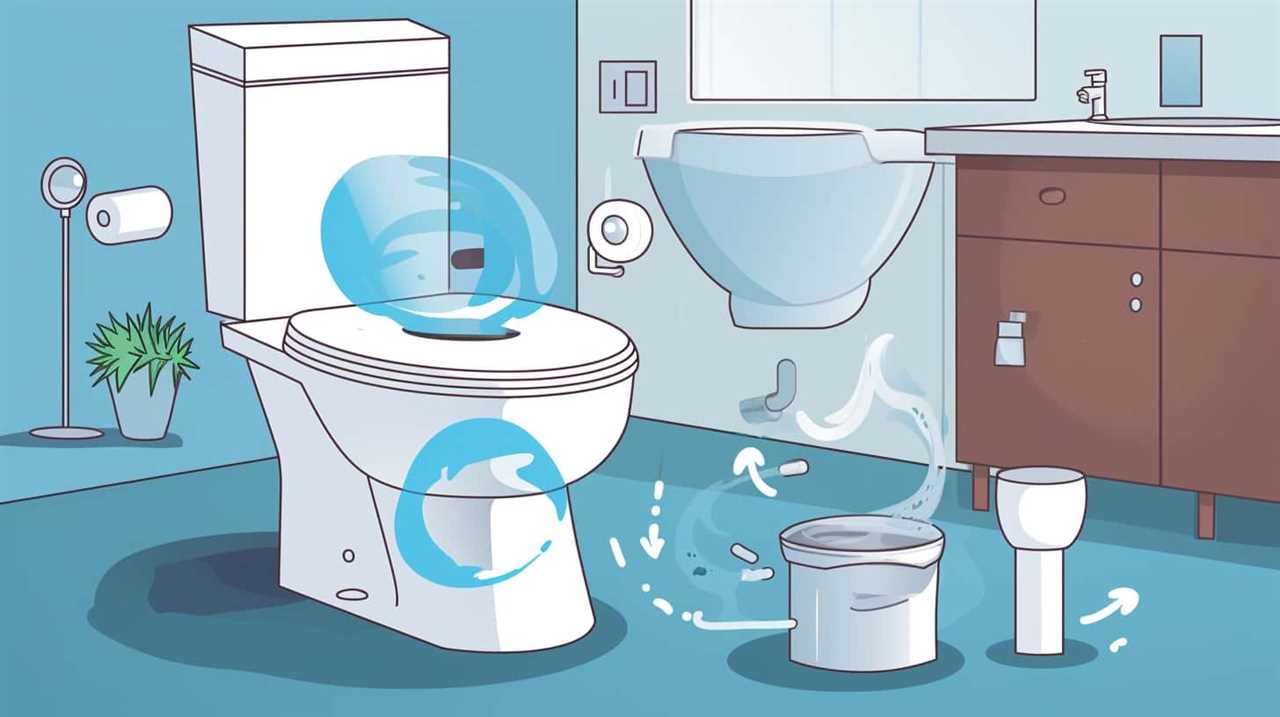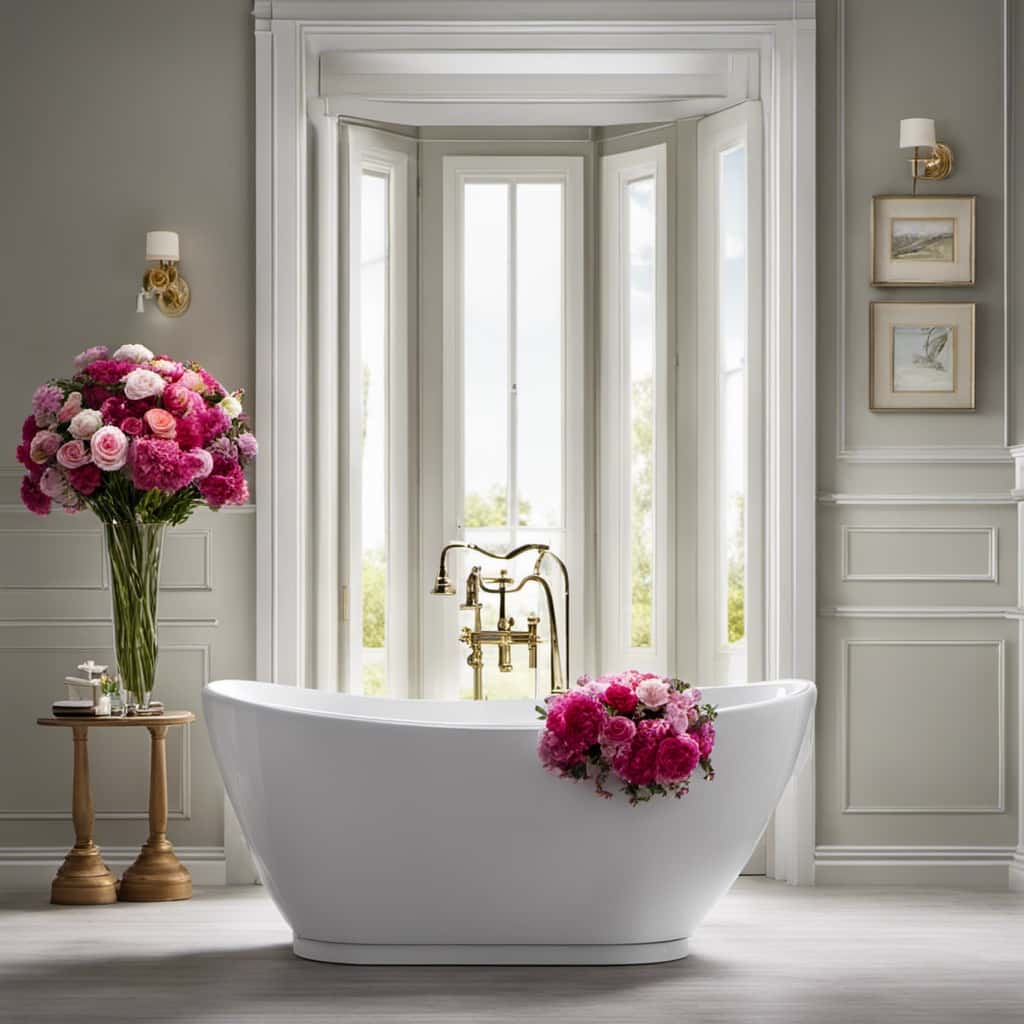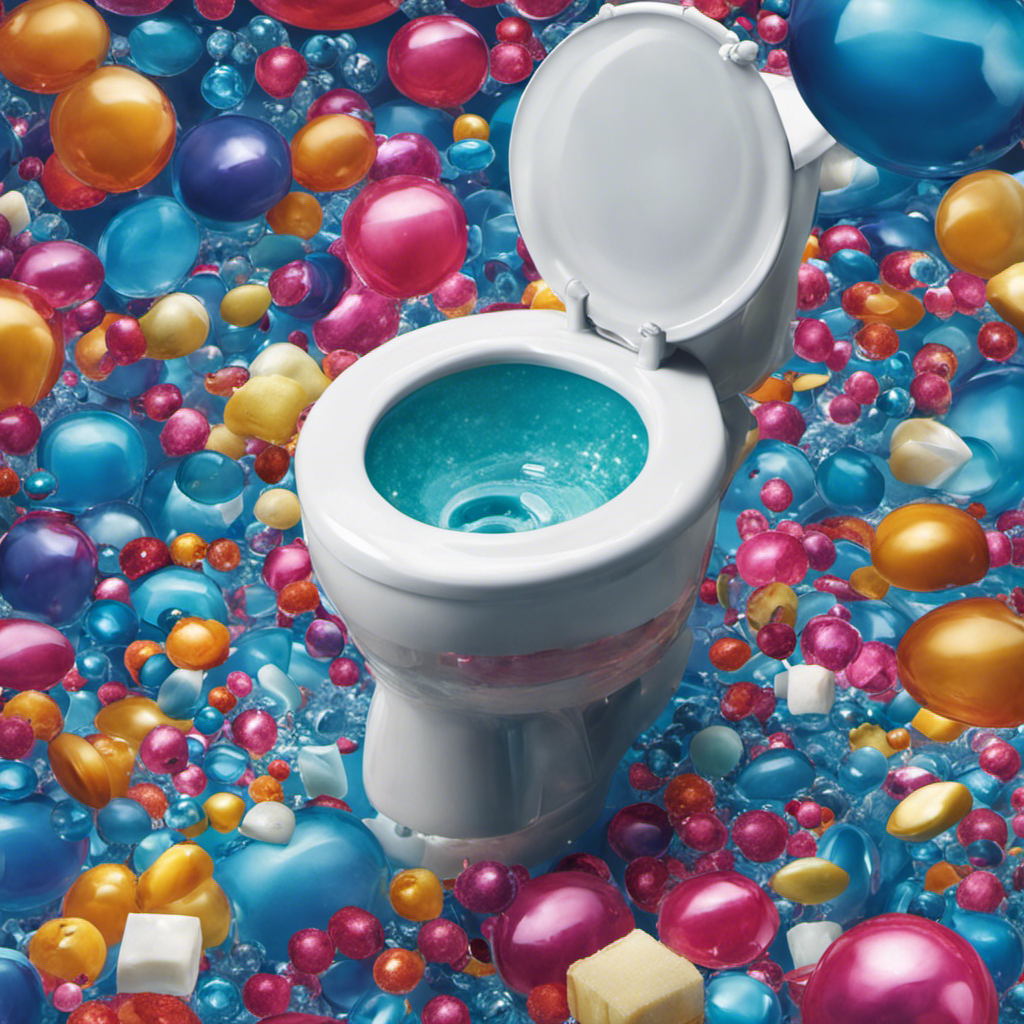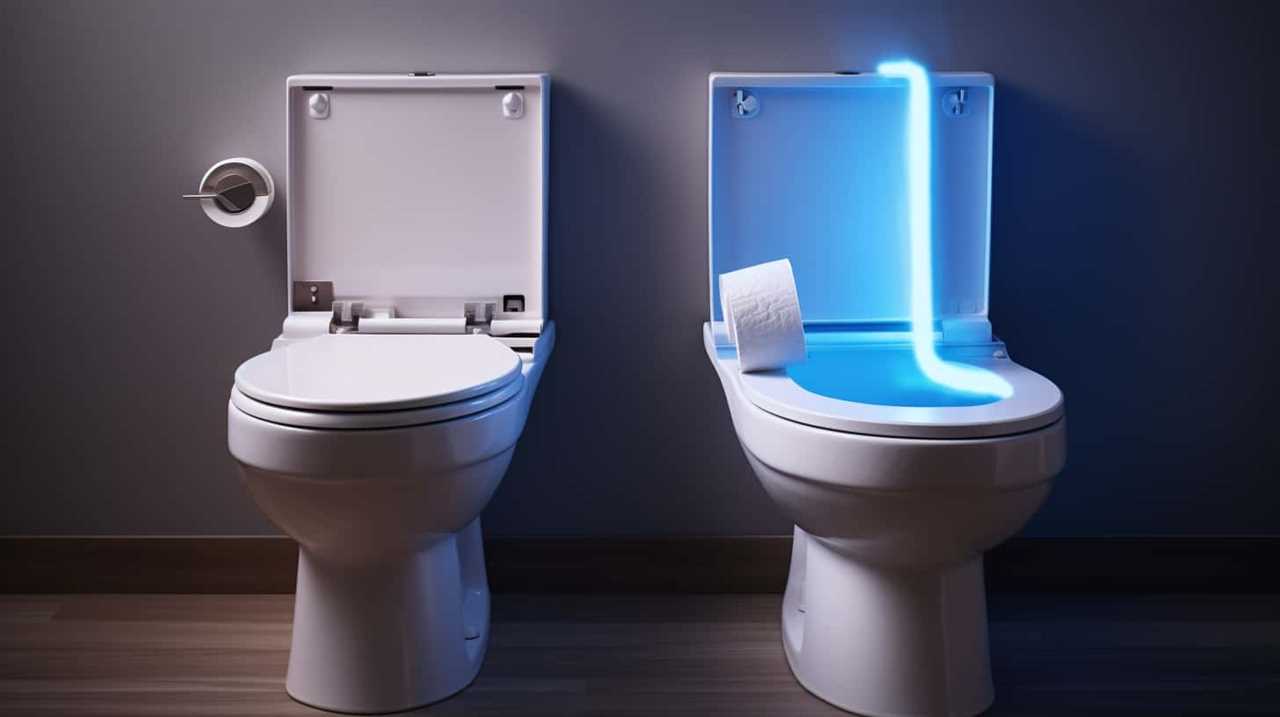Do we recommend getting dual flush toilets? Absolutely.
With water scarcity becoming an increasingly pressing issue, it is essential to explore ways to conserve water.
Dual flush toilets offer a solution by allowing users to choose between a low-volume flush for liquid waste and a higher-volume flush for solid waste.
This simple yet effective design change can lead to significant water savings, reducing our environmental impact and lowering water bills.

However, it is important to consider potential maintenance concerns and installation requirements before making the switch.
Key Takeaways
- Dual flush toilets save up to 68% more water than conventional toilets.
- They reduce strain on sewage systems and decrease the energy required for water treatment.
- Dual flush toilets offer long-term savings on utility bills.
- Regular maintenance and installation considerations should be taken into account.
Water Conservation Benefits
When it comes to water conservation, we’ve found that dual flush toilets are highly effective. These toilets are designed with a unique feature that allows users to choose between a full flush and a half flush, depending on their needs. This design significantly reduces water usage compared to traditional toilets.
The full flush is used for solid waste, while the half flush is sufficient for liquid waste. By giving users this choice, dual flush toilets promote efficient water usage without compromising on cleanliness.
Studies have shown that dual flush toilets can save up to 68% more water than conventional toilets. This makes them an excellent option for those who are conscious of their water consumption and want to contribute to water conservation efforts.

Environmental Impact Reduction
To reduce their environmental impact, dual flush toilets offer a practical solution for homeowners. These innovative fixtures provide the ability to choose between a half flush for liquid waste and a full flush for solid waste. This simple yet effective design change can have significant long-term sustainability benefits, including:
- Conserving water by using less for each flush
- Reducing strain on sewage systems by minimizing the volume of water entering the system
- Decreasing the energy required for water treatment and sewage processing
- Mitigating the risk of water scarcity by promoting responsible water usage
- Contributing to a healthier environment by minimizing the release of pollutants into water sources
By implementing dual flush toilets, homeowners can actively contribute to reducing their environmental footprint and promoting sustainable practices.
Now, let’s explore the cost efficiency of these toilets and their potential financial benefits.
Cost Efficiency
As homeowners, we can also appreciate the cost efficiency of dual flush toilets. Not only do they contribute to water conservation, but they also offer long-term savings on utility bills. Let’s take a closer look at the numbers:

| Flush Type | Water Usage (Gallons) |
|---|---|
| Full Flush | 1.6 |
| Half Flush | 0.8 |
| Average Flush | 1.2 |
Potential Maintenance Concerns
What maintenance concerns should we be aware of when using dual flush toilets?
Dual flush toilets offer many benefits, but it’s important to consider the potential maintenance requirements and long-term durability. Here are some key points to keep in mind:
- Regular cleaning: Dual flush toilets have more components, such as buttons or handles, which may require regular cleaning to prevent buildup of dirt or grime.
- Valve maintenance: The flush valves in dual flush toilets may need periodic maintenance or replacement to ensure proper functioning.
- Seal maintenance: The seals around the flush valves and water outlets should be checked regularly for leaks or wear.
- Water pressure: Dual flush toilets may be sensitive to variations in water pressure, so it’s important to ensure consistent pressure for optimal performance.
- Parts availability: Some dual flush toilets may have specific parts that aren’t readily available, making maintenance more challenging.
Considering these maintenance concerns, it’s crucial to also take into account the installation considerations when deciding whether dual flush toilets are a good idea.
Installation Considerations
When considering dual flush toilets, it is important to take into account the installation process and its associated considerations. Proper installation ensures optimal performance and longevity of the toilet system. One key consideration is water pressure. Dual flush toilets require adequate water pressure to effectively flush waste. Insufficient water pressure may result in incomplete flushing and potential clogging issues. Additionally, plumbing requirements should be considered. Dual flush toilets often require modifications to existing plumbing systems, such as installing a larger drain pipe or adjusting water supply lines. These modifications may require professional assistance and incur additional costs. To provide a clear overview, the table below summarizes the key installation considerations for dual flush toilets.

| Consideration | Description |
|---|---|
| Water Pressure | Adequate water pressure is essential for proper flushing. |
| Plumbing Requirements | Modifications to existing plumbing may be necessary for installation. |
Considering these installation considerations is crucial to ensure the proper functioning of a dual flush toilet system. Now, let’s explore the user experience and satisfaction with dual flush toilets.
User Experience and Satisfaction
Our experience with dual flush toilets has been overwhelmingly positive, with a majority of users expressing high levels of satisfaction. Through extensive user feedback and performance analysis, we’ve gathered valuable insights into the user experience of dual flush toilets.
Here are some key findings:
- Efficient flushing: Users appreciate the dual flush mechanism, which allows them to choose between a low-volume flush for liquid waste and a higher-volume flush for solid waste.
- Water savings: Many users reported significant reductions in water consumption, leading to both environmental and cost benefits.
- Effective waste removal: Dual flush toilets have proven to be highly effective in removing waste, ensuring cleanliness and hygiene.
- Durability and reliability: Users have praised the durability and reliability of dual flush toilets, with minimal instances of clogging or malfunctioning.
- Ease of use: The intuitive design and straightforward operation of dual flush toilets have contributed to a positive user experience.
With such positive user feedback and performance analysis, it’s clear that dual flush toilets offer a superior user experience compared to traditional toilets.

Comparison to Traditional Toilets
When comparing dual flush toilets to traditional toilets, several key points come to mind.
Firstly, dual flush toilets offer significant water-saving benefits, allowing users to choose between a low-flush option for liquids and a high-flush option for solid waste. This can result in substantial water conservation over time.
Additionally, dual flush toilets are known for their efficiency in flushing, ensuring strong and effective waste removal without the need for excessive water usage.
Lastly, while the initial cost of installing a dual flush toilet may be higher than that of a traditional toilet, the long-term cost-effectiveness of reduced water consumption can make it a worthwhile investment.

Water-Saving Benefits
To fully understand the water-saving benefits of dual flush toilets, we need to compare them to traditional toilets. Dual flush toilets are designed with water conservation in mind, offering two flushing options: a half flush for liquid waste and a full flush for solid waste. Here are some key points to consider:
- Dual flush toilets can reduce water consumption by up to 50% compared to traditional toilets.
- The half flush option uses significantly less water, making it more efficient for disposing of liquid waste.
- Traditional toilets typically use a fixed amount of water for every flush, regardless of the waste type.
- Dual flush toilets allow users to choose the appropriate flush for the waste, minimizing unnecessary water usage.
- The water-saving benefits of dual flush toilets contribute to environmental sustainability and lower water bills.
With these advantages in mind, let’s delve into the next section about the efficiency in flushing.
Efficiency in Flushing
In comparing the efficiency in flushing between dual flush toilets and traditional toilets, we can observe significant differences.
Dual flush toilets are designed to be more efficient in terms of water usage. They typically have two options for flushing: a low-volume flush for liquid waste and a high-volume flush for solid waste. This allows users to choose the appropriate flush based on their needs, resulting in water savings.

However, it’s important to note that efficiency in flushing isn’t solely determined by water usage. Water pressure and flushing power also play a crucial role. Traditional toilets often have a higher water pressure and more powerful flush, which can be beneficial in removing waste effectively. Dual flush toilets, on the other hand, may have a lower water pressure and flushing power, which may require multiple flushes to achieve the same level of cleanliness.
Transitioning into the subsequent section about ‘cost-effectiveness over time’, it’s essential to consider the trade-off between water savings and flushing efficiency when evaluating the overall efficiency of dual flush toilets.
Cost-Effectiveness Over Time
Our analysis of the cost-effectiveness over time of dual flush toilets compared to traditional toilets reveals significant savings in water and maintenance expenses. Dual flush toilets offer long term savings due to their efficient water usage, resulting in reduced water bills for homeowners.
Here are five key reasons why dual flush toilets are cost-effective over time:

- Water bill reduction: Dual flush toilets use less water per flush, leading to lower water consumption and reduced water bills.
- Maintenance savings: With fewer moving parts and simpler mechanisms, dual flush toilets require less maintenance and repair, saving homeowners money in the long run.
- Durability: Dual flush toilets are designed to be more durable and resistant to wear and tear, reducing the need for frequent replacements.
- Environmental impact: By conserving water, dual flush toilets contribute to sustainable practices and lower water usage.
- Increased property value: Installing dual flush toilets can increase the value of a property, providing homeowners with a return on their investment.
Frequently Asked Questions
How Much Water Can Be Saved by Using a Dual Flush Toilet Compared to a Traditional Toilet?
Using a dual flush toilet can significantly increase water efficiency compared to a traditional toilet. This has a positive environmental impact as it reduces water consumption, making it a good idea for conservation.
Are There Any Government Incentives or Rebates Available for Installing Dual Flush Toilets?
Government incentives and rebates are available for installing dual flush toilets, which help conserve water. These incentives encourage individuals to make environmentally-friendly choices and contribute to water savings.
Can a Dual Flush Toilet Be Easily Retrofitted Into an Existing Bathroom?
Retrofitting a dual flush toilet into an existing bathroom may pose challenges, such as plumbing modifications and space limitations. Cost implications include the price of the toilet itself and any necessary renovations.
Are There Any Specific Plumbing Requirements or Considerations for Installing a Dual Flush Toilet?
When considering the installation of a dual flush toilet, it is important to understand the plumbing requirements and installation considerations. These factors play a crucial role in ensuring a successful and efficient implementation.

Are There Any Potential Drawbacks or Disadvantages to Using a Dual Flush Toilet Compared to a Traditional Toilet?
There are potential drawbacks to using dual flush toilets compared to traditional ones. One concern is the environmental impact, as some models may not conserve as much water as claimed.
Conclusion
In conclusion, dual flush toilets offer a practical solution for conserving water, reducing environmental impact, and saving money in the long run.
Despite potential maintenance concerns, their installation and user experience have proven to be satisfactory.
With their efficient design and ability to cater to different waste types, dual flush toilets are a worthwhile investment for those seeking a cost-effective and environmentally conscious option.

So embrace this innovative approach and let your water usage flow smoothly, just like the dual flush mechanism.










